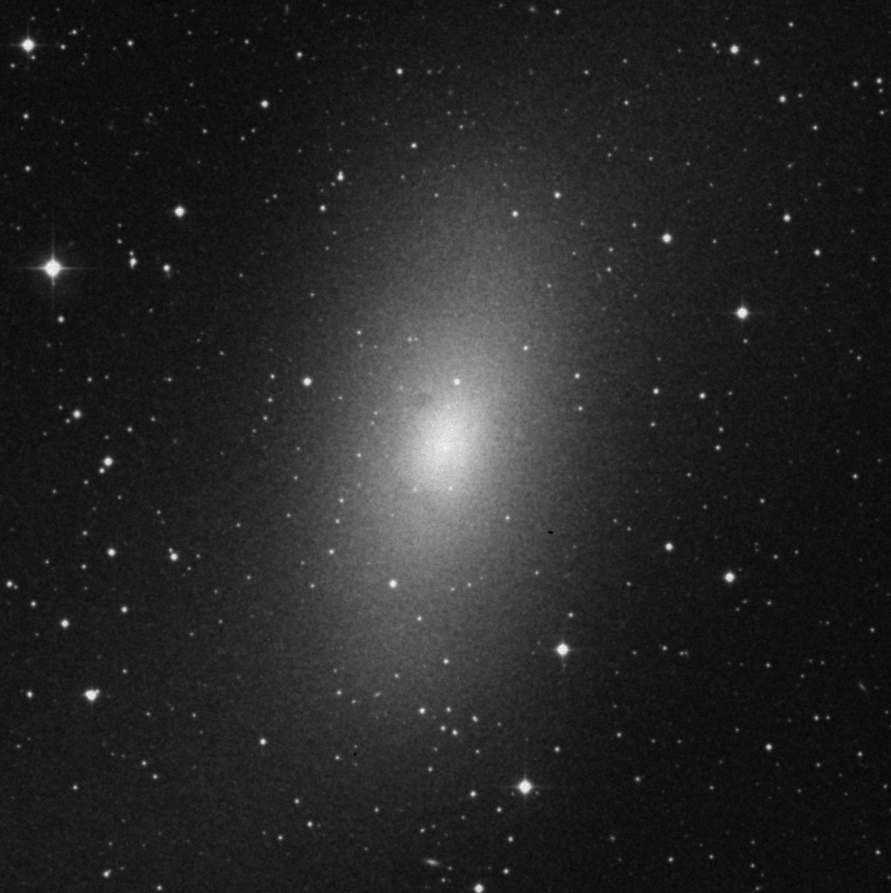Object Name: Messier 110
Alternative Designations: M110, NGC 205
Object Type: E6p Elliptical Galaxy
Constellation: Andromeda
Right Ascension: 00 : 40.4 (h:m)
Declination: +41 : 41 (deg:m)
Distance: 2900 (kly)
Visual Brightness: 8.5 (mag)
Apparent Dimension: 17×10 (arc min)
Locating Messier 110: M110 is easily located with smaller telescopes as the northeastern companion galaxy of M31 – the Great Andromeda Galaxy. It can be spotted as a small hazy patch in larger binoculars from a dark sky site and easily begins to display structure with a mid-sized telescope. While it isn’t as grand as its nearby neighbor, most backyard astronomers would find this bright little galaxy far more interesting if it were on its own! It is well suited to a small amount of light pollution and makes for an excellent suburban challenge.
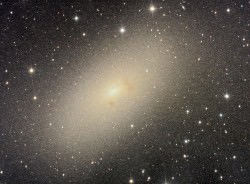 What You Are Looking At: Classified as a dwarf spheroidal galaxy, M110 enjoys its life some 2.9 million years away from our solar system on the outskirts of the Andromeda Galaxy. Despite its diminuative size, its an active little galaxy with a system of 8 globular clusters in a halo around it. “We present measurements of ages, metallicities and [?/Fe] ratios for 16 globular clusters (GCs) in NGC 147, 185 and 205 and of the central regions of the diffuse galaxy light in NGC 185 and 205. Our results are based on spectra obtained with the SCORPIO multislit spectrograph at the 6-m telescope of the Russian Academy of Sciences. We include in our analysis high-quality Hubble Space Telescope/WFPC2 photometry of individual stars in the studied GCs to investigate the influence of their horizontal branch (HB) morphology on the spectroscopic analysis. All our sample GCs appear to be old (T > 8 Gyr) and metal-poor ([Z/H]??1.1) , except for the GCs Hubble V in NGC 205 (T= 1.2 ± 0.6 Gyr, [Z/H]=?0.6 ± 0.2) , Hubble VI in NGC 205 (T= 4 ± 2 Gyr, [Z/H]=?0.8 ± 0.2) and FJJVII in NGC 185 (T= 7 ± 3 Gyr, [Z/H]=?0.8 ± 0.2) . The majority of our GCs sample has solar [?/Fe] enhancement in contrast to the halo population of GCs in M31 and the Milky Way.” says M.E. Sharina (et al). “The HB morphologies for our sample GCs follow the same behaviour with metallicity as younger halo Galactic GCs. We show that it is unlikely that they bias our spectroscopic age estimates based on Balmer absorption-line indices. Spectroscopic ages and metallicities of the central regions in NGC 205 and 185 coincide with those obtained from colour–magnitude diagrams. The central field stellar populations in these galaxies have approximately the same age as their most central GCs (Hubble V in NGC 205 and FJJIII in NGC 185), but are more metal-rich than the central GCs.”
What You Are Looking At: Classified as a dwarf spheroidal galaxy, M110 enjoys its life some 2.9 million years away from our solar system on the outskirts of the Andromeda Galaxy. Despite its diminuative size, its an active little galaxy with a system of 8 globular clusters in a halo around it. “We present measurements of ages, metallicities and [?/Fe] ratios for 16 globular clusters (GCs) in NGC 147, 185 and 205 and of the central regions of the diffuse galaxy light in NGC 185 and 205. Our results are based on spectra obtained with the SCORPIO multislit spectrograph at the 6-m telescope of the Russian Academy of Sciences. We include in our analysis high-quality Hubble Space Telescope/WFPC2 photometry of individual stars in the studied GCs to investigate the influence of their horizontal branch (HB) morphology on the spectroscopic analysis. All our sample GCs appear to be old (T > 8 Gyr) and metal-poor ([Z/H]??1.1) , except for the GCs Hubble V in NGC 205 (T= 1.2 ± 0.6 Gyr, [Z/H]=?0.6 ± 0.2) , Hubble VI in NGC 205 (T= 4 ± 2 Gyr, [Z/H]=?0.8 ± 0.2) and FJJVII in NGC 185 (T= 7 ± 3 Gyr, [Z/H]=?0.8 ± 0.2) . The majority of our GCs sample has solar [?/Fe] enhancement in contrast to the halo population of GCs in M31 and the Milky Way.” says M.E. Sharina (et al). “The HB morphologies for our sample GCs follow the same behaviour with metallicity as younger halo Galactic GCs. We show that it is unlikely that they bias our spectroscopic age estimates based on Balmer absorption-line indices. Spectroscopic ages and metallicities of the central regions in NGC 205 and 185 coincide with those obtained from colour–magnitude diagrams. The central field stellar populations in these galaxies have approximately the same age as their most central GCs (Hubble V in NGC 205 and FJJIII in NGC 185), but are more metal-rich than the central GCs.”
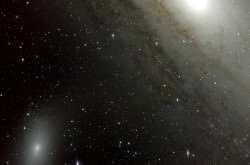 But globular clusters are old… Are there new stars forming inside of M110? “NGC 205 is a peculiar dwarf elliptical galaxy hosting in its center a population of young blue stars. Their origin is still matter of debate, the central fresh star formation activity possibly being related to dynamical interactions between NGC 205 and M31. The star formation history around the NGC 205 central nucleus is investigated in order to obtain clues to the origin of the young stellar population. Methods. Deep HST/ACS CCD photometry is compared with theoretical isochrones and luminosity functions to characterize the stellar content of the region under study and compute the recent SF rate. Our photometry reveals a previously undetected blue plume of young stars.” says L. Monaco (et al). “Our analysis suggests that (they) were produced between approximately 62 Myr and 335 Myr ago in the NGC 205 inner regions, with a latest minor episode occurring 25 Myr ago. The excellent fit of the observed luminosity function of young main sequence stars obtained with a model having a constant star formation rate argues against a tidally triggered star formation activity over the last 300 Myr. Rather, a constant SF may be consistent with NGC 205 being on its first interaction with M 31.”
But globular clusters are old… Are there new stars forming inside of M110? “NGC 205 is a peculiar dwarf elliptical galaxy hosting in its center a population of young blue stars. Their origin is still matter of debate, the central fresh star formation activity possibly being related to dynamical interactions between NGC 205 and M31. The star formation history around the NGC 205 central nucleus is investigated in order to obtain clues to the origin of the young stellar population. Methods. Deep HST/ACS CCD photometry is compared with theoretical isochrones and luminosity functions to characterize the stellar content of the region under study and compute the recent SF rate. Our photometry reveals a previously undetected blue plume of young stars.” says L. Monaco (et al). “Our analysis suggests that (they) were produced between approximately 62 Myr and 335 Myr ago in the NGC 205 inner regions, with a latest minor episode occurring 25 Myr ago. The excellent fit of the observed luminosity function of young main sequence stars obtained with a model having a constant star formation rate argues against a tidally triggered star formation activity over the last 300 Myr. Rather, a constant SF may be consistent with NGC 205 being on its first interaction with M 31.”
 Is that all? The let’s stir up the interstellar medium… “In order to understand what determines the properties of the interstellar medium (ISM) and the relation of that ISM to star formation, it is important to observe the ISM in a variety of environments unlike our solar neighborhood. One example of an environment different from the solar neighborhood is the interior of the dwarf elliptical galaxy NGC 205, a companion of M31.” says L.M. Young and K. Yo. “Though it is an elliptical, NGC 205 has long been classified as peculiar, because it has dust clouds and signs of recent star formation near its center. Therefore, given the general deficiency of gas and star formation in elliptical galaxies, NGC 205 presents an excellent opportunity to study the properties of the interstellar medium”
Is that all? The let’s stir up the interstellar medium… “In order to understand what determines the properties of the interstellar medium (ISM) and the relation of that ISM to star formation, it is important to observe the ISM in a variety of environments unlike our solar neighborhood. One example of an environment different from the solar neighborhood is the interior of the dwarf elliptical galaxy NGC 205, a companion of M31.” says L.M. Young and K. Yo. “Though it is an elliptical, NGC 205 has long been classified as peculiar, because it has dust clouds and signs of recent star formation near its center. Therefore, given the general deficiency of gas and star formation in elliptical galaxies, NGC 205 presents an excellent opportunity to study the properties of the interstellar medium”
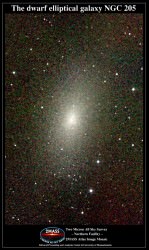 Having such a dominate neighbor isn’t easy, either. According to the work of K.M. Howley (et al): “NGC 205, a close satellite of the M31 galaxy, is our nearest example of a dwarf elliptical galaxy. Photometric and kinematic observations suggest NGC 205 is undergoing tidal distortion from its interaction with M31. Despite earlier attempts, the orbit and progenitor properties of NGC 205 are not well known. We perform an optimized search for these unknowns by combining a genetic algorithm with restricted N-body simulations of the interaction. Coupled with photometric and kinematic observations as constraints, this allows for an effective exploration of the parameter space. We represent NGC 205 as a static Hernquist potential with embedded massless test particles serving as tracers of surface brightness. We explore three distinct, initially stable test particle configurations: cold rotating disk, warm rotating disk, and hot, pressure-supported spheroid. Each model reproduces some, but not all, of NGC 205’s observed features, leading us to speculate that a rotating progenitor with substantial pressure support could match all of the observables.”
Having such a dominate neighbor isn’t easy, either. According to the work of K.M. Howley (et al): “NGC 205, a close satellite of the M31 galaxy, is our nearest example of a dwarf elliptical galaxy. Photometric and kinematic observations suggest NGC 205 is undergoing tidal distortion from its interaction with M31. Despite earlier attempts, the orbit and progenitor properties of NGC 205 are not well known. We perform an optimized search for these unknowns by combining a genetic algorithm with restricted N-body simulations of the interaction. Coupled with photometric and kinematic observations as constraints, this allows for an effective exploration of the parameter space. We represent NGC 205 as a static Hernquist potential with embedded massless test particles serving as tracers of surface brightness. We explore three distinct, initially stable test particle configurations: cold rotating disk, warm rotating disk, and hot, pressure-supported spheroid. Each model reproduces some, but not all, of NGC 205’s observed features, leading us to speculate that a rotating progenitor with substantial pressure support could match all of the observables.”
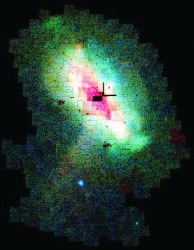 Did M110 form from M31, or is it just hanging on the coattails of its big brother? Let’s ask the Isaac Newton Telescope. “The initial results of this survey could not have been more surprising: despite exhibiting a near pristene disk, M31’s halo is full of substructure and points to a history of accretion and disruption. Metal-poor/young stars are coded blue whilst metal rich/older stars are coded red. This spectacular image shows in amazing detail the wealth of information that the INT is helping to reveal about the structure of this previously invisible region of galaxies. The most obvious piece of substructure visible is the giant stellar stream (visible in the south-east). This extends to near the edge of our survey —a projected distance of some 60kpc. In fact, by examining the systematic shift in the luminosity function of the stream as a function of galactocentric radius, we find its actual length is much greater than 100kpc. The similarity of the colour of this feature with the loop of material at the north of the survey suggests a connection: deep follow-up imaging using HST/ACS confirms that they possess the same stellar population. It seems likely that the northern feature is an extension of the stream, after it has passed very close to the centre of the potential of M31.” says Alan McConnachie (et al). “A second large stellar stream candidate has also been identified. The progenitor of this feature appears to be the satellite galaxy NGC 205, although this awaits spectroscopic confirmation. This object has long been known to be tidally perturbed but it is only now that the full extent of its disruption is becoming clear.”
Did M110 form from M31, or is it just hanging on the coattails of its big brother? Let’s ask the Isaac Newton Telescope. “The initial results of this survey could not have been more surprising: despite exhibiting a near pristene disk, M31’s halo is full of substructure and points to a history of accretion and disruption. Metal-poor/young stars are coded blue whilst metal rich/older stars are coded red. This spectacular image shows in amazing detail the wealth of information that the INT is helping to reveal about the structure of this previously invisible region of galaxies. The most obvious piece of substructure visible is the giant stellar stream (visible in the south-east). This extends to near the edge of our survey —a projected distance of some 60kpc. In fact, by examining the systematic shift in the luminosity function of the stream as a function of galactocentric radius, we find its actual length is much greater than 100kpc. The similarity of the colour of this feature with the loop of material at the north of the survey suggests a connection: deep follow-up imaging using HST/ACS confirms that they possess the same stellar population. It seems likely that the northern feature is an extension of the stream, after it has passed very close to the centre of the potential of M31.” says Alan McConnachie (et al). “A second large stellar stream candidate has also been identified. The progenitor of this feature appears to be the satellite galaxy NGC 205, although this awaits spectroscopic confirmation. This object has long been known to be tidally perturbed but it is only now that the full extent of its disruption is becoming clear.”
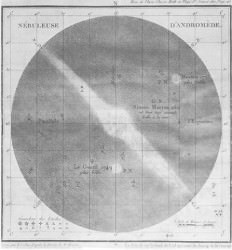 History: M110 was discovered by Charles Messier on August 10, 1773. In his notes he writes: “I examined, under a very good sky, the beautiful nebula of the girdle of Andromeda [M31], with my achromatic refractor, which I had made to magnify 68 times, for creating a drawing like the one of that in Orion [M42] (Mem. de l’acad. 1771, pag. 460). I saw that [nebula] which C. [Citizen] Legentil discovered on October 29, 1749 [M32]. I also saw a new, fainter one, placed north of the great [nebula], which was distant from it about 35′ in right ascension and 24′ in declination. It appeared to me amazing that this faint nebula has escaped [the discovery by] the astronomers and myself, since the discovery of the great [nebula] by Simon Marius in 1612, because when observing the great [nebula], the small is located in the same field [of view] of the telescope. I will give a drawing of that remarkable nebula in the girdle of Andromeda, with the two small which accompany it.”
History: M110 was discovered by Charles Messier on August 10, 1773. In his notes he writes: “I examined, under a very good sky, the beautiful nebula of the girdle of Andromeda [M31], with my achromatic refractor, which I had made to magnify 68 times, for creating a drawing like the one of that in Orion [M42] (Mem. de l’acad. 1771, pag. 460). I saw that [nebula] which C. [Citizen] Legentil discovered on October 29, 1749 [M32]. I also saw a new, fainter one, placed north of the great [nebula], which was distant from it about 35′ in right ascension and 24′ in declination. It appeared to me amazing that this faint nebula has escaped [the discovery by] the astronomers and myself, since the discovery of the great [nebula] by Simon Marius in 1612, because when observing the great [nebula], the small is located in the same field [of view] of the telescope. I will give a drawing of that remarkable nebula in the girdle of Andromeda, with the two small which accompany it.”
Caroline Herschel independently discovered M110 on August 27, 1783, little more than 10 years after Messier, and William Herschel numbered it H V.18 when he cataloged it on October 5, 1784 and placed in his notes: “.. There is a very considerable, broad, pretty faint, small nebula near it [M31]; my Sister [Caroline] discovered it August 27, 1783, with a Newtonian 2-feet sweeper. It shews the same faint colour with the great one, and is, no doubt, in the neighborhood of it. It is not [M32] ..; but this is about two-thirds of a degree north preceding it, in a line parallel to Beta and Nu Andromedae.”
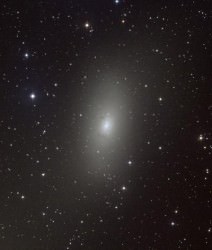 M110 would later be cataloged by John Herschel and poetically observed by Admiral Smyth: “A large faintish nebula of an oval form, with its major axis extending north and south. It it between the left arm and robes of Andromeda, a little to the np [North Preceding, NW] of 31 Messier; and was discovered by Miss Herschel in 1783, with a Newtonian 2-foot [FL] sweeper. It lies between two sets of stars, consisting of four each, and each disposed like the figure 7, the preceding group being the smallest; besides other telescopic stars to the south, This mysterious apparition was registered by H [William Herschel] as 30′ long and 12′ broad, but only half that size by his son; and there was a faint suspicion of a nucleus. This doubt must stand over for the present, – for whatever was a matter of uncertainty in the 20-foot reflector, would have no chance of definition in my instrument. It was carefully differentiated with Beta Andromedae.”
M110 would later be cataloged by John Herschel and poetically observed by Admiral Smyth: “A large faintish nebula of an oval form, with its major axis extending north and south. It it between the left arm and robes of Andromeda, a little to the np [North Preceding, NW] of 31 Messier; and was discovered by Miss Herschel in 1783, with a Newtonian 2-foot [FL] sweeper. It lies between two sets of stars, consisting of four each, and each disposed like the figure 7, the preceding group being the smallest; besides other telescopic stars to the south, This mysterious apparition was registered by H [William Herschel] as 30′ long and 12′ broad, but only half that size by his son; and there was a faint suspicion of a nucleus. This doubt must stand over for the present, – for whatever was a matter of uncertainty in the 20-foot reflector, would have no chance of definition in my instrument. It was carefully differentiated with Beta Andromedae.”
Enjoy this great little galaxy!
Top M110 image credit, Palomar Observatory courtesy of Caltech, M110 courtesy of J.C. Cuillandre, CFHT, M110 Image by Lowell Observatory, M110 by Adam Block/NOAO/AURA/NSF, Messier’s Andromeda and Companion Sketch (public image) and M110 image courtesy of NOAO/AURA/NSF.

